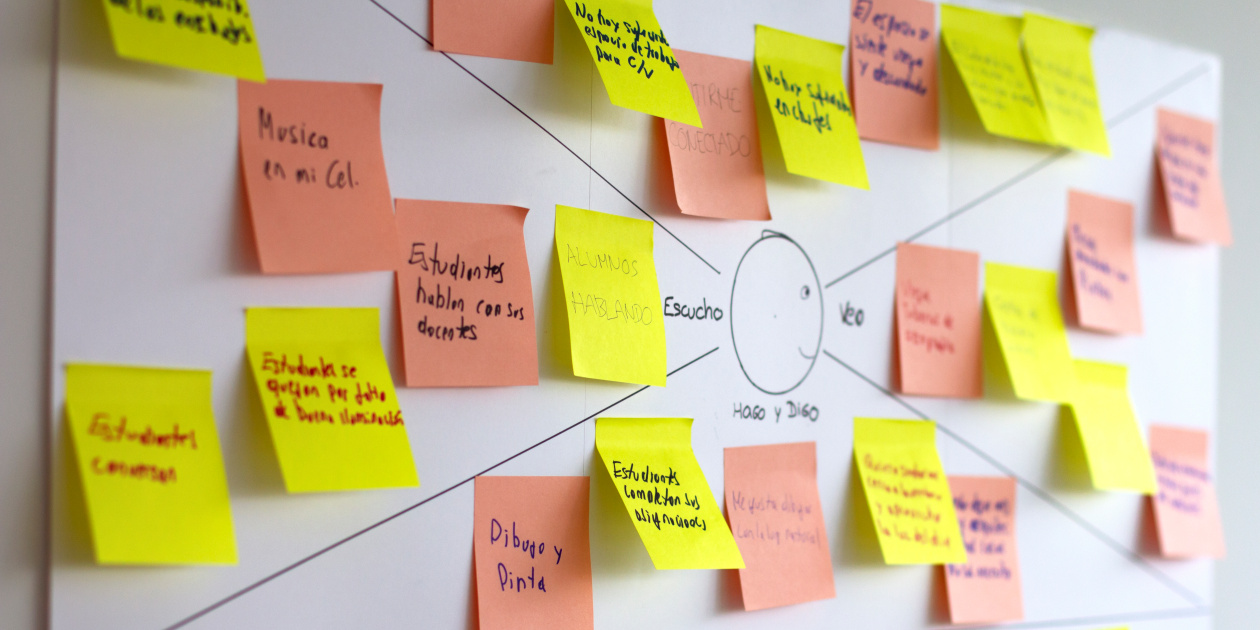
The design thinking approach has gained popularity across all areas of business as an innovative problem-solving strategy. It brings cross-functional teams together to break out of their natural day-to-day patterns and unpack business challenges with a customer-centric mindset. The ability to work and think differently to flesh out early-stage solutions in a short timeframe has given design thinking its positive reputation. It's useful for innovation, strategy development, process improvement, and more.
Depending on the goals and context, design thinking can take many forms. For example, you can add small exercises to weekly meetings, conduct 1-day workshops, or run full 5-day design sprints. In this article, we walk through how to run a 1-day design thinking workshop to create strategic solutions and solve problems that might be holding you – or your customers – back.
The goal of a design thinking workshop is to create an actionable game plan that your team can use to solve customer challenges or capitalize on market opportunities that push an organization forward. The workshop includes the following six exercises that cover internal and external topics and allow team members to think out of the box. Take time during each exercise to share ideas and reflect on potential directions offered.
1. Define Your Challenge and Objectives
Before starting the workshop, scope out the challenge you want to tackle and determine the primary objectives.
2. Identify Crucial Stakeholders
A design thinking workshop begins with bringing together a cross-functional group of team leads from different departments such as customer service, sales, engineering, and marketing. When teams that don’t typically work together align around a common purpose and collaborate on challenges, it dramatically increases their ability to organize complexity, empathize with customers, and design effective solutions.
Your chosen stakeholders will likely need some education about what a design thinking workshop is, what their role will be, and what to expect. Create a communication and project management process to ensure that stakeholders stay engaged and follow through as needed.
3. Enabler and Blocker Discovery
Share the challenge with the stakeholders and discuss ideas about what is holding something back (blocker) and what is propelling it forward (enabler).
Internal Forces: Unpack different points of view from stakeholders, and examine where successes reside and challenges lurk within the company or with customers. After you share the results, gather feedback and determine the top two internal enablers and blockers.
External Forces: Look at external forces such as technology and demographic trends, uncertainties, and competitors and separate external factors into opportunities and threats. It’s a good way for your team to take a step back and look at what’s happening in the world around them and how it could potentially impact their business model. Select the top four external factors your team thinks should be kept top of mind.
4. Fundamental Assumptions Development
Next, you want to understand and empathize with the customers your products or services are designed for. In this exercise, put yourself in the user’s shoes and create customer personas. Work with your team to brainstorm ideas about:
- What benefits users are seeking
- What makes users happy
- What tasks users are trying to complete
- What problems users are trying to solve
- What’s preventing users from getting their jobs done
- What risks and obstacles are related to users’ jobs.
After you’ve answered those questions, find ways to challenge assumptions made. With a deeper understanding of your customers, you can create a better product, set of services, and user experience.
5. Solution Design
After your team has taken a deep look at the factors that affect their offering, work together to sketch out the best attributes of the product or service. Then, bring it all together and start brainstorming big picture ideas about how to solve the challenge, keeping everything uncovered during the workshop in mind. For example, if the goal of the workshop is innovation, come up with an idea that improves customer lives, serves new customer segments, or delivers against unmet customer needs.
Select and score the top brainstorm ideas based on impact and feasibility. Decide, as a team, what idea to pursue. Determine the metrics and criteria required to test your hypothesis.
6. Game Plan the Future
After you’ve identified the top idea, build out the framework. Demonstrate the:
- Mechanics of the idea
- Resources needed
- Value created
- Critical assumptions
Create a game plan that outlines the tasks that need to get done over the next few months to move the top idea forward to its desired future state. Set up the analytics and reports required to make data-driven decisions about what’s working and what needs course-correcting.
Once you’ve completed the design thinking workshop, your stakeholders will have aligned on what steps need to be taken for them to be successful. They'll have the necessary tools to identify hidden customer needs and improve customer experience.
Many teams are reaping the benefits design thinking has to offer for solving business challenges and creating innovative solutions. What’s holding you back?  if you’d like help facilitating an effective design thinking workshop for your team.
if you’d like help facilitating an effective design thinking workshop for your team.
